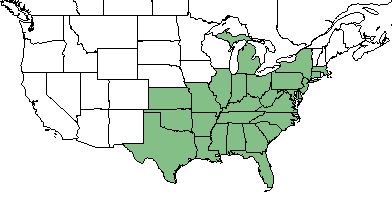Paspalum laeve
Common Names: field paspalum[1], field crowngrass[2]
| Paspalum laeve | |
|---|---|

| |
| Photo by Keith Bradley hosted at Atlas of Florida Plants | |
| Scientific classification | |
| Kingdom: | Plantae |
| Division: | Magnoliophyta - Flowering plants |
| Class: | Liliopsida - Moncots |
| Order: | Poales |
| Family: | Poaceae |
| Genus: | Paspalum |
| Species: | P. laeve |
| Binomial name | |
| Paspalum laeve Michx. | |

| |
| Natural range of Paspalum laeve from USDA NRCS Plants Database. | |
Contents
Taxonomic Notes
Synonyms: P. circulare Nash; P. longipilum (Nash).[3]
Variety: Paspalum laeve Michaux var. circulare (Nash) Stone; Paspalum laeve Michaux var. laeve.[3]
Description
P. laeve is a cespitose, perennial graminoid of the Poaceae family that is native to North America.[1] It's culms are 3-7.5 dm tall with glabrous nodes and internodes. Blades are 20 cm long, 1-10 mm wide, and have a papillose-pilose texture. The sheaths are papillose-pilose as well, with ciliate margins and 2 mm long ligules. There are 2-3 racemes are racemose, spreading, 3-7 mm long, 1 mm wide, and have a scaberulous rachis wing. Growing in 2 rows, the spikelets are orbicular and 2.5-3 mm broad with scaberulous pedicels.
Distribution
P. laeve is found throughout the southeastern United States, reaching as far north as New York and Michigan, and as far west as Texas and Kansas.[1]
Ecology
Habitat
This perennial grass is commonly found on forest edges and disturbed areas.[4] Specimens have been collected from habitats that include moist loamy sands at the edges of a pond, grassy slopes of a roadside ditch, open pine/oak flatwoods, coastal hammocks, open swamp margins, dried up pond bottoms, wet sands od a marsh, small swale, wiregrass palmetto flatwoods, cypress pond, low field, and old pasture.[5]
The grass has an intermediate level of shade and drought tolerance.[1]
Phenology
P. laeve flowers from June through August.[6]
Conservation and Management
Cultivation and restoration
Photo Gallery
References and notes
- ↑ 1.0 1.1 1.2 1.3 USDA Plant Database
- ↑ Orzell, S. L. and E. L. Bridges (2006). "Floristic composition of the south-central Florida dry prairie landscape." Florida Ecosystem 1(3): 123-133.
- ↑ 3.0 3.1 Weakley, A.S. 2015. Flora of the southern and mid-atlantic states. Working Draft of 21 May 2015. University of North Carolina at Chapel Hill, Chapel Hill, North Carolina.
- ↑ Weakley, A. S. (2015). Flora of the Southern and Mid-Atlantic States. Chapel Hill, NC, University of North Carolina Herbarium.
- ↑ URL: http://herbarium.bio.fsu.edu. Last accessed: June 2018. Collectors: Loran C. Anderson, Wilson Baker, R.K. Godfrey, R. Kral, P.L. Redfearn, Sidney McDaniel, William Adams, C.V. Piper, R.A. Pursell, D.L. Martin, S. T. Cooper, A.H. Curtis, Allen Shuey, R. Norris, Cecil Slaughter, John B. Nelson, Steve Bennett, P. Ferral, A. Williams, Danielle Dodier. States and counties: Florida (Wakulla, Jackson, Bay, Liberty, Nassau, Taylor, Okaloosa, Brevard, Escambia, Madison, Leon, Charlotte, Jefferson, Marion, Manatee, Duval, Calhoun, Washington) Georgia (Clinch, Charlton, Thomas) South Carolina (Berkeley) Texas (Madison)
- ↑ Nelson, G. PanFlora: Plant data for the eastern United States with emphasis on the Southeastern Coastal Plains, Florida, and the Florida Panhandle. www.gilnelson.com/PanFlora/ Accessed: 24 MAY 2018